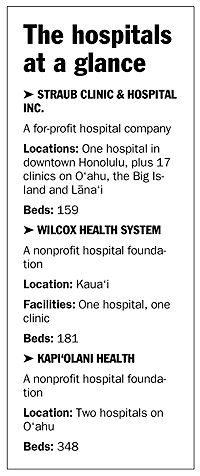By John Duchemin
Advertiser Staff Writer
 A proposed merger between three of Hawai‘i’s largest hospital companies could not only subtly improve care for thousands of patients, but also could be the key to the companies’ survival. A proposed merger between three of Hawai‘i’s largest hospital companies could not only subtly improve care for thousands of patients, but also could be the key to the companies’ survival.
Kapi‘olani Health, Straub Clinic & Hospital and Wilcox Health System of Kaua‘i have each approved plans to merge operations, although hospital officials said yesterday that a merger is far from complete. Kapi‘olani Health and Straub’s boards only approved the merger earlier this week, and it now faces about six months of regulatory scrutiny, public commentary and financial due diligence.
The move comes as all of Hawai‘i’s hospitals are going through lean times, despite an expanding local economy. Hospitals nationwide are struggling as government Medicare payments have dwindled since 1997, when Congress passed the Balanced Budget Act that slashed reimbursements.
That means hospitals are often forced to absorb much, if not all, of Medicare patients’ costs. The resulting costs have been staggering: In Hawai‘i alone, hospitals have lost $1.9 billion over the past five years, said Rich Meiers, president of the Hawai‘i Healthcare Association, which represents all the state’s hospitals.
"Everyone’s grappling with the same problem: We’re getting less money to provide the same services, and those are services that cost a lot," said Ann Nishida, spokeswoman for Straub, which she said is barely breaking even on its operations.
In that environment, the proposed merger is only natural, said Allan Robb, a veteran health administrator and vice dean of hospital and business affairs at University of Hawai‘i’s John A. Burns School of Medicine.
A merger would let the hospitals share profits, cushion one another from losses, combine or eliminate duplicated programs and wield more clout in medical supply markets.
"Health care today is very much a business, and like other businesses, they’re forced to cut costs in tough times," Robb said. "It’s a fact of economic survival, and it’s not unusual for hospitals to merge in situations like this."
Unified laundry operation
The losses have forced Hawai‘i hospitals to cooperate to save money, starting unified laundry operations and consolidating the disposal of medical waste. But institutions including Straub and Queen’s Medical Center have also been forced to cut staff and programs like Queen’s dental and cardiac rehabilitation centers.
A merger could help the hospitals avoid such cuts, observers said. Changes could be largely invisible to most patients — but the impact could be big.
"As a patient, you probably wouldn’t see anything right off the bat — most of the change will be behind the scenes," Robb said. "But under the whole system that would be developed after the merger, you’d eventually see a lot of improvements. If they’re able to reduce or maintain costs, hospitals usually give savings back to patients. So by saving in one area, they could maintain services they might not otherwise be able to keep — or possibly offer services they’ve never had before."
Hospital officials said yesterday they still haven’t determined how they might change their operations. But industry observers said the merger follows Mainland trends and could produce similar results.
Combining functions
The hospitals could combine administrative functions including payroll, human resources, purchasing, billing and regulatory compliance. Purchasing could be pooled to give the hospitals a bulk-buying edge in medical supply markets. Doctors could share medical records more quickly and efficiently, interact more with peers at the other hospitals and generally provide better "continuity of care," said Robb.
On O‘ahu, Kapi‘olani and Straub could help each other specialize in key fields by making selective improvements, said Nishida.
"If both hospitals need to upgrade, then maybe Kapi‘olani could upgrade its ob-gyn ward, and Straub could upgrade some of its labs, instead of both upgrading in all the areas," she said.
On Kaua‘i, Wilcox could benefit from sharing the O‘ahu hospitals’ support services, and from improved access to the Kapi‘olani and Straub physicians for research and teaching, said Lani Yukimura, director of marketing for Wilcox.
"There’s things they have, and we don’t have, that we’d be able to access easier," Yukimura said.
[back to top] |

 A proposed merger between three of Hawai‘i’s largest hospital companies could not only subtly improve care for thousands of patients, but also could be the key to the companies’ survival.
A proposed merger between three of Hawai‘i’s largest hospital companies could not only subtly improve care for thousands of patients, but also could be the key to the companies’ survival.